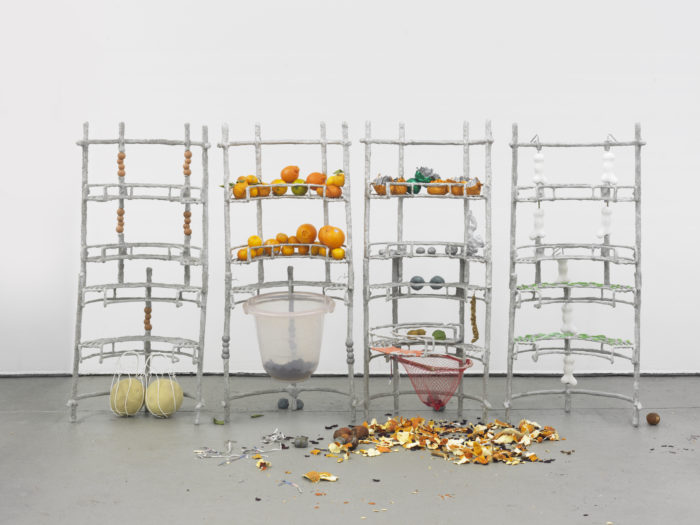
Nancy Lupo is gluing tiny polypropylene pellets to the cover of a 1994 Dodge Caravan when I arrive at her downtown Los Angeles studio. “They’re for stress,” she explains of the tiny objects, which are reminiscent of the sort one might find inside a tension relief ball. We slip into a conversation about materials, like stress balls and Soylent, that have been co-opted by Silicon Valley and rebranded for the capitalist worker bee. This interrogation of how objects act in context is oft-visited territory for Lupo.
The bedazzled tarp is one of the pieces she will show at the Hammer Museum’s biennial “Made in L.A. 2018,” which opens in June and runs through early September. Those who know Lupo’s work will recognize her nuanced use of materials that make the familiar less so to the viewer. Her installations generally include ordinary objects— furniture, dog bowls and plastic Rubbermaid trash cans, to name just a few. “It all has to be ‘real’ stuff, because what else is there?” she asks. “Everything is something. Even paint is a mixture of calcium carbonate and other materials.”

“For me, the art is in the space that a form holds,” she says. “The trash can isn’t exactly a sculpture—it’s an activator. I want the viewer to reevaluate the actual thing they are seeing in the world.” This sort of revelation is precisely what an encounter with Lupo’s art provides. A series of her benches included in “Made in L.A.” are derived from those the artist saw on the streets of Shanghai and LA. “I’m interested in asking how these objects become visible,” she says. “The art is somewhere in between the park, literally as it is, and something else.” We discuss how, when walking in a city, one is likely unaware of the area’s larger context and layout. “There’s a moment when you’re just a body, alive, and you can’t see these geometries or designs in the streets,” she says. “But if you have some sort of vantage, you have access to so much information.”
Lupo’s practice provides both immersion and perspective. To engage with her work is to view the way objects present themselves to the artist, and to then reevaluate how they present to oneself. A park, Lupo says, is a space “to be deeply inside of your body, locked in your emotions, sensing what it is to be alive.” The same could certainly be said of experiencing her work.



